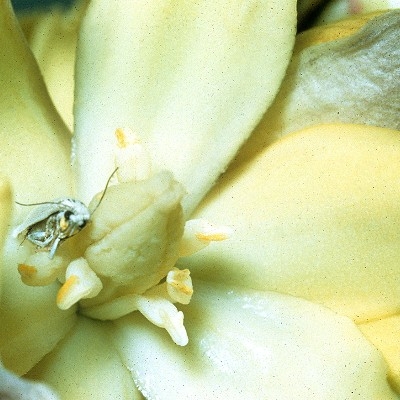
https://mojavedesert.net/trees/yucca-brevifolia
Introduction The relationship between Joshua trees (Yucca brevifolia) and yucca moths (Tegeticula synthetica) is a classic example of mutualism, where both species benefit from their interaction. This symbiotic relationship is essential for the reproduction of Joshua trees and the lifecycle of yucca moths.
Yucca Moth Pollination Process
- Flowering: Joshua trees typically bloom from February to late April, producing clusters of creamy white to green flowers. The blooming process depends on sufficient rainfall and a winter freeze.
- Moth Activity: Female yucca moths visit Joshua tree flowers during their active period. Unlike most insects that visit flowers for nectar, yucca moths have a unique role. The female moth collects pollen from the anthers of one flower and forms it into a ball using specialized tentacles near her mouth.
- Pollination: The moth deliberately transfers the pollen ball to the stigma of another Joshua tree flower. This deliberate act ensures cross-pollination, which is crucial for the genetic diversity and reproductive success of the Joshua tree.
- Egg Laying: After pollinating the flower, the female moth lays her eggs inside the flower’s ovary. This ensures that her larvae will have a food source when they hatch.
- Larval Feeding: As the seeds develop within the flower’s ovary, the moth eggs hatch into larvae. These larvae feed on a portion of the developing seeds. Despite this seed predation, enough seeds typically remain viable to ensure successful reproduction of the Joshua tree.
Selective Abortion Joshua trees have developed a mechanism to ensure seed survival despite the larvae feeding. They can selectively abort ovaries that contain too many moth eggs. This limits the number of larvae that can develop and ensures that sufficient seeds remain viable for the tree’s reproduction.
Mutual Benefits
- For the Joshua Tree: The deliberate pollination by the yucca moth increases the likelihood of successful seed set and promotes genetic diversity due to cross-pollination.
- For the Yucca Moth: The Joshua tree provides a secure environment for the moth to lay its eggs and a reliable food source for the larvae.
Unique Adaptations
- Yucca Moth: Specialized tentacles for collecting and transferring pollen. This adaptation is unique among insects and has specifically evolved to pollinate Joshua trees.
- Joshua Tree: Flower structure that accommodates the yucca moth’s pollination behavior. The tree’s ability to selectively abort seed pods with too many larvae is also a crucial adaptation for managing seed predation.
Ecological Importance The relationship between Joshua trees and yucca moths is a cornerstone of the Mojave Desert ecosystem. This mutualism ensures the reproduction and survival of Joshua trees and supports a complex web of life, providing food and habitat for various species of birds, mammals, reptiles, and insects.
Conclusion The intricate pollination mechanism between Joshua trees and yucca moths highlights these species’ deep co-evolution and interdependence. This mutualistic relationship is essential for their survival and plays a vital role in maintaining the ecological balance of the Mojave Desert.